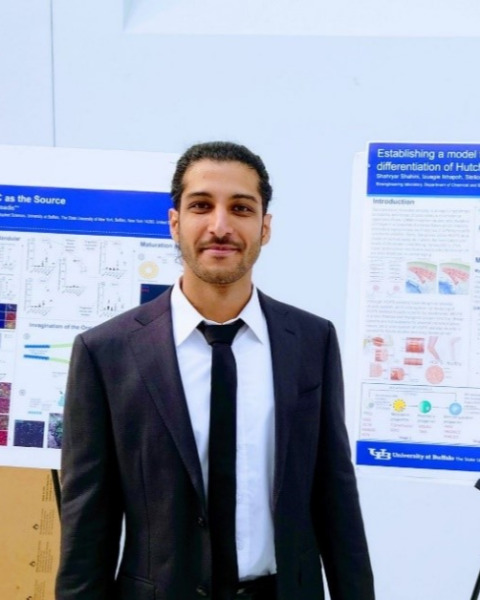Tissue Engineering
Tissue Engineering - Poster Session A
Poster BB16 - Derivation of Skeletal Myoblasts from Human Hutchinson-Gilford Progeria Syndrome iPSCs as a Model of Muscle Aging
Thursday, October 24, 2024
10:00 AM - 11:00 AM EST
Location: Exhibit Hall E, F & G

Shahryar Shahini
PhD Student
University at buffalo
Getzville, New York, United States
Stelios T. Andreadis, PhD (he/him/his)
Professor
University at Buffalo
Amherst, New York, United States
Presenting Author(s)
Primary Investigator(s)
Introduction: Sarcopenia or muscular atrophy, denotes the degenerative loss of muscle mass and strength observed in elderly individuals, leading to frailty. The primary pathological mechanism underlying sarcopenia is compromised muscle regeneration from satellite cells inhabiting the skeletal muscle niche. Hutchinson-Gilford Progeria Syndrome (HGPS) or accelerated aging disorder results from a mutation in the LMNA gene, which encodes lamin A/C. This mutation leads to the production of a toxic protein called progerin, which causes dysregulation of several biological processes, including chromatin remodeling, transcriptional regulation, DNA repair, and nuclear membrane-associated factors, similar to those observed in physiological aging. Patients afflicted with HGPS commonly manifest growth retardation, diminished muscle mass, and skeletal muscle atrophy. Despite the skeletal muscle growth deficits evident in HGPS, the establishment of an in vitro model recapitulating HGPS skeletal muscle remains elusive. Induced Pluripotent Stem Cell (iPSC) technology offers a solution by enabling the derivation of myoblasts from HGPS patient-derived iPSCs. Previous work showed that HGPS iPSCs accurately replicate disease characteristics, including nuclear abnormalities and increased DNA damage, across various cell types like neural progenitors, endothelial cells, fibroblasts, Vascular Smooth Muscle Cells, and mesenchymal stem cells. These results motivated us to derive skeletal myoblasts from HGPS iPSCs and examine the onset of aging hallmarks at various stages of differentiation. This model can be used to study accelerated muscle aging and serve as a screening platform for testing potential anti-aging treatments.
Materials and
Methods: In this study, we derived myogenic cells from iPSCs from HGPS patients as a model for skeletal muscle aging. To obtain these cells, we developed a three-stage differentiation protocol (Figure A) from two HGPS and two healthy control cell lines using a commercially available differentiation media. Four cell lines including two HGPS and two healthy controls were used for differentiation using this protocol. In order to examine myogenic differentiation, somite and myogenic markers were analyzed using RT-PCR and immunostaining at the end of each stage. Beyond differentiation markers, we analyzed senescence and metabolic markers including DNA damage, Senescence-associated β-galactosidase (SA-β-gal), Reactive Oxygen Species (ROS) using DCFDA staining, Mitochondrial membrane potential by TMRM staining, Mitochondrial respiration and glycolytic capacity assays using seahorse assay.
Results, Conclusions, and Discussions: Our results showed that there was no significant difference in pluripotency genes between HGPS and non-HGPS iPSCs, however, we observed accumulation of Progerin and DNA damage in HGPS iPSCs even in early stages of differentiation (Figure B). In agreement, Western blots showed very low levels of Lamin A/C, and no expression of Prelamin A and Progerin in HGPS iPSCs but high expression in myoblasts derived from these cells (Figure C). This was accompanied by abnormal nuclear structure and nuclear blebbing (Figure D), and higher senescence-associated β-galactosidase (SA-βgal, Figure E, F) in the HGPS-iPSC-derived myogenic cells compared to controls. Additionally, HGPS myoblasts showed higher levels of reactive oxygen species (ROS) (DCFDA staining, Figure G, H) and lower mitochondrial membrane potential (TMRM staining, Figure I, J). In addition, HGPS myoblasts exhibited impaired mitochondrial respiration (Figure K) and lower glycolytic capacity (not shown). Finally, HGPS iPSCs differentiated less efficiently into myotubes (Figure L), as indicated by reduced cell fusion (Figure M) and impaired expression of myogenic regulatory factors (Figure N). In conclusion, we observed the onset of aging hallmarks in HGPS-derived myogenic cells, even during early stages of differentiation. This led to decreased myogenic differentiation potential and impaired myotube formation. These results form the basis for future studies to probe into the mechanisms of aging and employ this system as a platform for drug screening to alleviate aging hallmarks, potentially reducing reliance on animal models and enabling personalized approaches in drug discovery utilizing patient-derived cells.
Acknowledgements (Optional):
